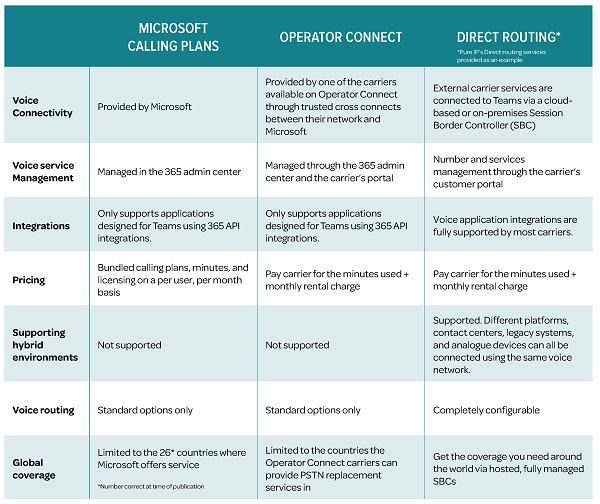With over 145 million daily users and rising, it is no surprise to see Microsoft continually announcing new features and developments for their unified communications platform, Teams. One area they have clearly prioritized in recent months is the development of Teams Calling options, as part of a strategy to increase the number of businesses using Teams as their telephone system. With the Operator Connect service option
announced in March, for example, Microsoft aims to streamline the process by enabling customers to add external PSTN calling to Teams from directly within the Teams admin center.
Together with Direct Routing and Microsoft’s own Calling Plans, Operator Connect presents users with a third option for migrating their telephony to Teams. One way to think about it is that these options represent three alternatives on a sliding scale, with Operator Connect positioned in the middle as an option that balances the convenience of ordering services through Microsoft with the flexibility of Direct Routing.
Calling Plans vs. Operator Connect vs. Direct Routing
Although on the surface these three voice connectivity solutions are similar, key differences make each suitable for distinct use cases.
Microsoft Calling Plans are ideal for organizations without complex requirements that are looking for a voice service they can activate quickly and easily on a per-user basis. It is especially convenient for businesses that might value the regular monthly price for budgeting reasons, and might like that they can manage their whole communications stack through the 365 admin center.
Direct Routing sits at the other end of the scale, supporting organizations that need more flexibility and have more complex requirements. These requirements could be anything from sophisticated configurations to the integration of other applications such as contact centers. There are also cost benefits available, particularly through providers offering more transparent “pay for what you use” pricing models. Any organization that is interested in consolidating their voice systems to a single network, achieving greater feature parity with their previous phone system, or adding regional offices in areas Microsoft doesn’t cover, has needed the flexibility of Direct Routing — which is why it is currently the most popular option.
Operator Connect comes some way towards filling the gap between the two, allowing organizations to add and manage basic voice services through Microsoft, choose their own carrier, and access some of the cost savings of Direct Routing. It is important to note, however, that anything beyond basic voice requirements will still need to be arranged directly with an external provider.
Let’s take a closer look at some of the key information that might affect an organization’s decision if they were considering migrating their telephony to Microsoft Teams.
Why Choose Operator Connect?
There are a number of reasons to select Operator Connect for voice calling in Teams. They are:
- Data security & call quality — Operator Connect works through trusted cross-connects, which are direct private links between the Microsoft and carrier networks. That means one fewer hop on a public network that your calls need to go through to connect, resulting in better quality and security. That said, some Operator Connect carriers can also now use the same trusted cross-connects to provide the same benefits to their Direct Routing customers.
- Convenience — Operator Connect can remove the complexity of having to manage numbers internally through Microsoft PowerShell, instead allowing users to make use of the Teams interface, which is much less technical. Activating and deactivating users in Operator Connect is much easier than in Direct Routing, where licenses and configuration might need to be managed separately.
- Coverage and pricing — As noted earlier, your organization may need voice services in regions that Microsoft simply doesn’t include in their Calling Plans. Many organizations also find that they no longer need all the minutes provided in the bundles and would rather pay only for the minutes that they do use.
- Users with different requirements — There are some limited circumstances when your organization might opt to mix and match Operator Connect with Direct Routing. For example, you might have teams that only need basic telephone functionality, and can be added through Operator Connect, as well as teams with advanced call queue requirements that can only be satisfied through Direct Routing.
In all, Operator Connect presents an interesting proposition to those organizations with relatively vanilla requirements and that can afford to sacrifice the flexibility of Direct Routing in favor of ease of use. It also opens up the cost reductions of Direct Routing to smaller businesses that might not necessarily have the resources, or desire, to manage multiple carriers, and would rather deal with as much as possible through Microsoft systems.











